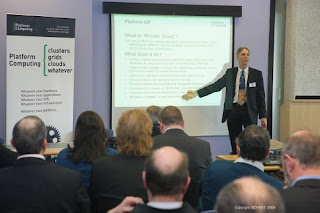We thought we’d share a quick list of some of the industry blogs the Platform Computing team reads and considers to be the most insightful and informative in the blogosphere. We surveyed the staff and here are our collective favorites in our markets. In the spirit of sparking conversation, we encourage your recommendations on others we should check out, as well. In no particular order, here they are:
1)
InfoWorld’s Cloud Computing Blog, Dave LinthicumDave is undeniably one of the world’s foremost authorities on Cloud and SOA. His InfoWorld blog offers insightful and pithy commentary on the advances and pitfalls of cloud computing, along with news and market trends.
http://infoworld.com/blogs/dlinthicum2)
Forrester Blog for Infrastructure and Operations Professionals, James StatenAs a principal analyst, James tackles a range of topics and trends relative to infrastructure and operations professionals, including cloud computing infrastructures, cloud services, virtualization, and M&A activity in the cloud and virtualization marketplace.
http://blogs.forrester.com/it_infrastructure/3)
BriefingsDirect, Dana GardnerDana is an independent analyst and forward-thinking blogger and podcaster who writes about software productivity trends and new IT business growth opportunities. Dana is president and principal analyst at Interarbor Solutions and also a founding member and a weekly contributor to the Gillmor Gang podcast.
http://blogs.zdnet.com/Gardner or
http://www.briefingsdirect.com/4)
Gartner Blog Network, Thomas Bittman
As a vice president and distinguished analyst at Gartner, Thomas coined the term “real-time infrastructure” and is an expert on cloud computing, virtualization and infrastructure evolution. His blog focuses exclusively on cloud computing, the future of infrastructure, virtualization and the market players.
http://blogs.gartner.com/thomas_bittman/5)
GigaOmAs the founder of GigaOm, Om Malik, along with is colleague bloggers, Stacy Higginbotham and Derrick Harris, keep close track of the news, trends, policy and events happening in Silicon Valley and the greater tech industry.
http://gigaom.com/6)
Information Week’s Plug Into The CloudThis aggregate site pulls relevant cloud news and opinions from some of the IT industry’s best-known bloggers and journalists, including Charles Babcock and John Foley.
http://www.informationweek.com/cloud-computing/7) Javelin Strategy & Research Blog
Various analysts including Mary Monahan, James Van Dyke, and Bruce Cundiff at Javelin cover banking technology and financial services.
http://www.javelinstrategy.com/category/blog/8)
CNET – The Wisdom of Clouds, James Urquhart
James’ 20 years of experience in distributed systems development and deployment have provided him with a specialization in SOA, cloud computing, and virtualization. He’s currently market manager for the Data Center 3.0 strategy at Cisco Systems and a CNET Blog Network author. The advice and opinions expressed on all things cloud in his blog are strictly his own.
http://news.cnet.com/wisdom-of-clouds/9)
ZDNet – Virtually Speaking, Dan Kusnetzky
Dan jointly pens the Virtually Speaking with Paul Rooney, an IT industry journalist and blogger with more than 15 years of experience. Dan is currently vice president of research operations at The 415 Group and brings years of experience and wisdom from his near 40 years in the IT industry to his posts.
http://blogs.zdnet.com/virtualization/?tag=trunk;content10)
Thinking Out Cloud, Geva Perry
Geva describes himself as “a software executive, cloud computing pundit and advisor to companies in enterprise software and cloud computing” and provides great technical insight and guidance on the cloud.
http://gevaperry.typepad.com/11) Canadian Business - On investing, markets and personal finance, Larry MacDonald
As a former economist, Larry blogs about economic trends, stock market news and investment topics relevant to Canada. He’s authored several business books, including corporate biographies of Nortel and Bombardier, and manages his own portfolio.
http://blog.canadianbusiness.com/category/larry-macdonald/12) Cloudscaling, Randy Bias
As the founder & chief technologist for Cloudscaling. His boutique cloud strategy consulting firm, Cloudscaling, advises Fortune 500 companies with their internal cloud initiatives. He has driven innovations in infrastructure, IT, Operations, and 24×7 service delivery since 1990.
http://cloudscaling.com/blog13) CNET -
The Pervasive Datacenter, Gordon Haff
Gordon Haff is a principal IT advisor at market research firm Illuminata and focuses on computing infrastructure issues: enterprise servers, datacenter interconnects, operating systems, server blades and appliances, virtualization and the evolution of computing architecture. His Pervasive Datacenter blog discusses everything that’s hot and what’s not in enterprise computing.
http://news.cnet.com/pervasive-datacenter/14)
Gartner Blog Network, Kristin Moyer
Kristin Moyer is a research director for Gartner in Industry Advisory Services/Banking and Investment Services, blogging on a variety of relevant issues and trends for banking and investment services organizations.
http://blogs.gartner.com/kristin_moyer/15)
Vitualization.comCreated as an aggregate resource site on virtualization, the site also focuses on cloud computing and related technologies and features news, guest blog posts, interviews, white papers, people, jobs, photos, exclusive videos and reports about partnerships, M&A, events and rumors from the industry. Virtualization expert, Tarry Singh, is one of the guest editors.
http://www.virtualization.com16)
OnStrategies Perspectives, Tony Baer
Currently an analyst with Ovum, Tony has been following the IT industry for nearly two decades. His blog focuses on macro-level trends and events influencing innovation in the areas of SOA and Web Services, BPM, BI, Cloud Computing, SaaS, and software development.
http://www.onstrategies.com/blog/


